Horizontal floor-standing autoclaves Systec H-Series
The Systec H-Series floor-standing autoclaves of the performance category HX can be used for all laboratory applications, even for sophisticated sterilization processes and are available in 16 different sizes with 65 to 1580 liters chamber volume. The new, improved generation of Systec H-Series autoclaves comes in a new design, with a fully revamped interior and a completely new touchscreen control. The combination of new features guarantees higher work precision, easier maintenance of devices, shorter and more efficient process times.
All Systec autoclaves can be upgraded on a modular basis, with options and equipment to optimize sterilization processes for performing validatable sterilization procedures.
AVAILABLE WITH FOUR CHAMBER DIAMETER: 400 MM, 500 MM, 740 MM and 1000 MM
Systec HX
For all laboratory applications even for sophisticated state-of-the-art sterilization processes. With all possibilities to add additional options for process optimization to enable validatable sterilization to be carried out.
Dimensions and performance
Chamber dimensions
Ø x depth (mm)
Chamber volume
in liters total / nominal
Techn. Drawings
Electrical connections for:
Systec HX-65 to HX-200: 380 – 400 V, 50 / 60 Hz, 16 A.
Systec HX-210 to HX-650: 380 – 400 V, 50 / 60 Hz, 32 A.
Systec HX-580 to HX-1580: 380 – 400 V, 50 / 60 Hz, 32 A.
Different voltage available on request.
Standard Features
HXSystec HX
Integrated steam generator separated from the chamber
Housing, support frame and pressure chamber, made of corrosion-resistant stainless stee
Temperature and pressure range 140 °C, 4 bar absolute pressure
The pressure vessel of the autoclave is made of corrosion-resistant stainless steel 1.4404 (AISI 316L)
All connections on the pressure vessel are designed as Tri-Clamp
Touch screen control
Number of sterilization programs (up to 100)
Code-secured access rights for changing parameters and further safety-relevant intervention
Internal memory capacity for storing up to 10 years of data backups
Timer for programmable start time
Flexible PT-100 temperature sensor (class A)
Additional temperature sensor in condensate exhaust
Special program for Durham tubes
Calculation of F0 value
Special program for destructive sterilization with fractional heating for more efficient venting
Waste water temperature is water-cooled and thermostatically controlled
Adjustable automatic opening of door at end of program
Network and USB ports for external data transfer
Text input for batch information (up to 20 characters)
User account control (standard). The standard user account control has three permanently pre-configured and fixed user groups, each with one available user (Administrator, Operator or Supervisor).
Validation port for introducing measuring equipment
Integrated feature for comprehensive batch documentation, with export as PDF and CSV
Time synchronization with time server via network or internet
Available options
Extension of temperature and pressure ranges to 150 °C / 5 bar absolute pressure
All fittings and valves in the supply lines (from media connection to sterilization chamber) for demineralized water, steam or compressed air are made of stainless steel. All piping is made of FDA-certified PTFE
Keep-warm function for liquids after program has finished
Potential-free contact: It can be used to establish an external potential-free connection to one or more digital outputs or device status lines. It helps to prevent malfunctions when switching external actuators (such as signal lamps, valves and pumps).
Combined heating: The combined heating function supplements the built-in steam generator with an external steam heating option
External steam supply: connection to an external steam source (house steam)
Additional programs: such as hydrolitic resistance of glassware*, rubber-closure test**, ramp programs, material test programs
Feature for the integration into LIMS and SCADA systems via OPC UA
Up to 5 additional PT-100 temperature sensors
Options for process optimization
Rapid cooling for efficient and safe cooling of liquids
Radial ventilator and Ultracooler to speed up the cooling process
Spray heating and / or spray cooling for fast heating and cooling of liquids
Steam-air mixture method: Support pressure during the heating, sterilization and cooling phases. Particularly suitable for vessels which are at risk of bursting or deformation, and for sealed vessels.
Vacuum system to carry out the validated sterilization of solids and wastes in disposal bags
Superdry for drying solids (only in combination with optional vacuum system)
Exhaust air filtration (including condensate deactivation) for safe sterilization of hazardous biological substances
Options for documentation
Integrated printer for batch documentation
Save to Folder. Automatic data transfer via FTP/SFTP
Enhanced user account control: Up to 100 user and 100 groups can be configured and administered
Advanced CFR 21 Part 11 solution including AuditTrail. Enables run data to be electronically signed (so that it is tamper-proof). Documentation of all changes to the device and all alarm messages.
Personalized certificates for electronic signatures of run data (only applicable with the extended user account control)
*According to EP 3.2.1 and USP
**According to EP 3.2.9 and USP
Systec autoclaves are delivered ready for subsequent installation of all options.
Further options and special programs as well as baskets and inserts, transport and loading systems on request.
For further information on the options and accessories please click on "Options".
-
Design

Diameter 1000mm 
Diameter 740mm State-of-the-art engineering
Systec autoclaves ensure a new quality of laboratory sterilization processes.Available with four chamber diameter
Available with four chamber diameter: 400 mm, 500 mm, 740 mm and 1000 mm diameter.All-round quality
The pressure vessel is made of corrosion-resistant stainless steel 316L (1.4404) and is easy to clean. An approved safety valve for excess pressure is included. The autoclave support framework and housing are also made of stainless steel. The highly efficient, high-quality melamine foam insulation material releases no particles; Systec autoclaves can be used under clean-room conditions.
Dual sensors as standard
Temperature and pressure are controlled via an electronic pressure sensor, as well as a flexible temperature sensor in the chamber or in a reference vessel (with liquids). Systec HX autoclaves also have an additional temperature sensor in the floor drain.
Systec autoclaves are fitted with the following connections at the rear:
HX Demineralized water inlet for steam generation – Compressed air (Systec HX-65 to HX-200) – Compressed air (Systec HX-210 to HX-1580) – Cooling water – Common outlet – Network /USB – Flexible cord with CEE plug – Connection to cooling circuit (Systec HX-65 to HX-200) – Connection to cooling circuit (Systec HX-210 to HX-1580) – – = Standard– = Optional
All according to standards and regulations
The pressure vessel of the Systec H-Series is designed for operations at 150 °C and 5 bar absolute pressure. Optional temperature and pressure range extension accessories adapt all control and safety components to the higher temperature and pressure. This option can be retrofitted.
Combinated heating
The combined heating function supplements the built-in steam generator with an external steam heating. A program can be configured to use the internal or external steam heating option. The external steam is supplied at its own connection by the customer‘s facility. -
Steam generation
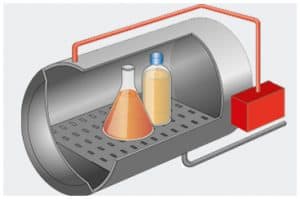
Steam generation by steam generator HX
A separate steam generator is incorporated in the housing.This has numerous advantages:
- No heating elements and no reservoir for dirty water in the chamber
- In conjunction with the stand-by pre-heating function, only 10 min. heating time to 121 °C with an empty chamber is required
- Improved air removal by suppressing the air to the bottom with its natural gravitation
- Quicker cooling as neither the hot water in the chamber nor the separate steam generator need to be cooled
- After cooling, steam is immediately available for the next sterilization run
Condensation of steam instead of removal HX
Exhaust steam is condensed automatically via a PT-100-regulated cooling system. This prevents odors and protects waste water piping that may be made of plastic. -
Operation

Operation by touch screen Operation by Touch-Screen technology
Operation is easy and rapid via a large (5.7 inch) touch screen interface for direct reading. This innovation oers additional options and increased flexibility when working with the autoclave. For example, process data can be displayed numerically or graphically. 7 programs are pre-defined but can be expanded (up to 100) as required by the user. To create a new program, the user is guided through the process by a menu dialog. Every new program is automatically assigned to a permanent, unalterable name and can also be given an individual designation by the user. All process parameters can be individually altered.Pre-defined programs
1 Solids
2 Waste bags
3 Liquid waste
4 Liquids
5 Cleaning
6 Vacuum test*
7 Bowie-Dick test*These can be expanded to 100 sterilization programs.
* Only in combination with a vacuum device. -
Safety

Automatic door-opening system Automatic door-opening system
Easy but safe – on closing, the door is automatically locked by a circumferential ring system. A special lip seal made of heatresistant silicone provides reliable tightness; the more the steam pressure increases, the tighter the seal becomes – without the need for additional compressed air or other media! The door-locking system is temperature-controlled according to the safety requirements for electrical equipment for measurement, control, and laboratory use (DIN EN (IEC) 61010-2-040). The door remains locked as long as there is excess pressure in the chamber. The door and other parts of the pressure vessel and housing are made of stainless steel. The attractively designed front cover, which also incorporates the control panel, display and parts of the control processing system, is made of heatresistant, insulating plastic. There is no risk for the operator of coming into contact with hot components.
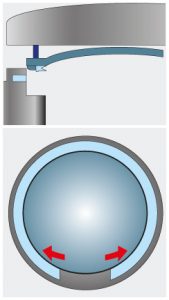
The autoclave door-opening works autonomously – either by pressing a button or automatically at the end of a program. A simple system but most useful in practice. Residual steam is exhausted automatically without intermission. Residual heat is used to dry the items being sterilized during a final short phase in the autoclave. Automatic door-opening is restricted to an angle of approx. 15°; this avoids possible contamination from the outside. This is especially useful when sterilized items have to remain in the autoclave for cooling and drying. Subsequently, for removing the sterilized items, the door can be completely opened manually.
-
Standards and regulations
Systec autoclaves comply with the following standards and regulations:
Pressure vessel:
- 2014/68/EU Pressure Equipment Directive
- ASME Boiler & Pressure Vessel Code, Section VIII, Division 1
- China Stamp
Other guidelines:
- 2014 / 35 / EU Low Voltage Directive
- 2014 /30 / EU on Electromagnetic Compatibility
All autoclaves are CE marked.
We will be happy to provide a complete list of standards and summary of regulations on request.
-
 Sterilization load and sterilization process
Sterilization load and sterilization process
Select the right process for every sterilization application
Several options are available that are necessary to obtain correct and validatable results and rapid cooling times, especially in the case of liquids. The options available depend on the items to be sterilized. A validatable sterilization process of biological efficiency can only be obtained if the correct instrument configuration is used.The table below provides help in establishing the desired configuration. Please ask our experts for additional advice!
Ventilation Cooling Drying Other Gravitation Simplepre-vacuumPulsed excesspressureFractionatedpre-vacuumConventionalcooling withslow pressurereleaseRapid coolingsystem withsupportpressureSurface dryingwithoutvacuumDrying withsubsequentvacuum+ SuperdryExhaust airfiltrationLiquids + ? – – ? + ? – Unpacked non hollow items+ + + + ? + Porous materials (filters, fabrics)– ? ? + + Hollow items (pipette tips,empty glassware, tubesand hoses)– – – + – + Contaminated waste indestruction bags– – ? + – – + + Recommended procedure ? Possibly acceptable – Not possible
-
 Sterilization of liquids
Sterilization of liquids
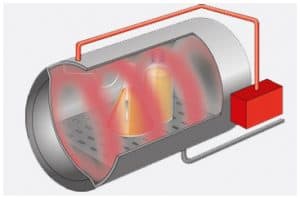
Sterilization heating up Heating up
The actual sterilization time of e.g. 15 minutes at 121 °C is only a fraction of the total time involved for an autoclave procedure. Especially in the case of sterilizing liquids, the heating up and cooling down phases are considerably longer.The conventional procedure
In previously used conventional systems, even if the intended sterilization temperature has been reached within the autoclave, the liquids to be sterilized are often only at about 60-90°C; the temperature equilibrium time between chamber and liquids normally takes much longer.Up to 50 % shorter heat-up times as standard
Due to the combined temperature and pressure regulation, the chamber pressure is increased during the heat-up phase. The result: more rapid temperature equilibrium in the liquids and a shorter heat-up time.
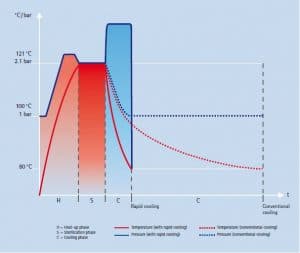
Conventional cooling vs. Rapid cooling Cooling
The cooling process for liquids is also very slow; this is because, without active rapid cooling, the heat can only be reduced to below 100 °C by dissipating the heat via the chamber insulation by radiation (see diagram: conventional cooling). New system- and process technology makes it possible to substantially reduce the overall time required for the sterilization process (see diagram: rapid cooling).Various optional rapid cooling systems enable the cooling times for liquids to be significantly reduced. This conserves culture media and makes for efficient utilization of the autoclave.
In addition to conventional cooling by regulated steam exhaust down to 100 °C and subsequent very slow self-cooling down to 80 °C, optional cooling systems for rapid cooling are available.
- Cooling with ambient air ventilation
- Mantle cooling with cooling water
- Mantle cooling with cooling water and support pressure
- Radial ventilator for air circulation and accelerated heat removal from the chamber
- Ultracooler
- Spray cooling with recirculated and recooled sterile water and support pressure

Mantle cooling with cooling water and support pressure Mantle cooling with cooling water and support pressure HX
During the entire sterilization process a flexible PT-100 temperature sensor monitors the temperature in a reference vessel. It is guaranteed that the sterilization period begins only once the sterilization temperature has been attained in the liquid to be sterilized. In accordance with relevant standards to prevent delayed boiling, the lid can only be opened once the temperature of the liquid has been reduced to at least 80 °C. The use of support pressure in the form of sterile-filtered compressed air during the cooling phase reliably prevents the culture medium from boiling.
Advantages:
- No loss of liquid due to boiling of the culture media
- Improved productivity from reduced cycle times and the full utilization of the filling volume in each bottle
- Prevention of delayed and over-boiling
- Prevention of the risk of bottles bursting during or after sterilization
- Prevention of re-contamination by the use of hermetically sealed bottles during sterilization
- Reduction of cooling time by up to 60 %
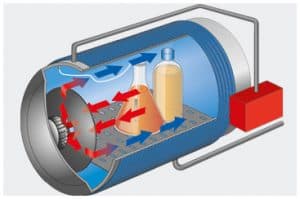
Radial ventilator Radial Ventilator HX
In conjunction with optional mantle cooling with cooling water and support pressure, the radial ventilator ensures accelerated removal of heat from the sterilization items to the cooled chamber mantle. The radial ventilator is placed in the door of the sterilization chamber so that the usable space in the autoclave is not reduced!- Ventilation performance 250 m3/h
- Reduction of cooling time by up to 70 %
Ultracooler HX
In conjunction with optional mantle cooling with cooling water, support pressure and radial ventilator, it is possible to significantly reduce the recooling time and the entire sterilization process by integrating of the additional ultracooler heat exchanger. The Ultracooler is also placed in the door of the sterilization chamber near the radial ventilator so that the usable space in the autoclave is not reduced.
Ultracooler - Reduction of cooling time by up to 90 %
- Depending on the load, cooling times between 15 and 60 minutes can be achieved
-
 Sterilization of solids
Sterilization of solids
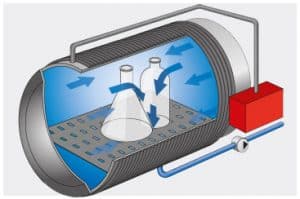
Vacuum system Vacuum system HX
Typical solids are pipette tips (in boxes), empty glassware and porous materials such as filters or fabrics. The vacuum device effectively removes the air from solids, tubing, porous materials, and fabrics, allowing the steam to penetrate completely. The process includes a fractionated pre-vacuum phase in combination with the standard steam generator.
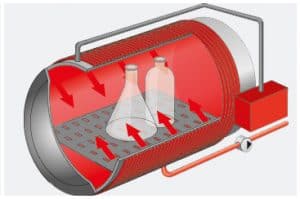
Superdry Superdry – for drying solids HX
This optional accessory increases the drying efficiency for solids and porous materials such as filters and fabrics. Heat energy from the standard steam generator is transferred to the heating coils around the body of the sterilization chamber and is used for drying. Deep-vacuum drying using the optional vacuum device in conjuction with Superdry avoids the necessity for subsequent drying in a separate drying cabinet. -
 Sterilization of waste in disposal bags
Sterilization of waste in disposal bags
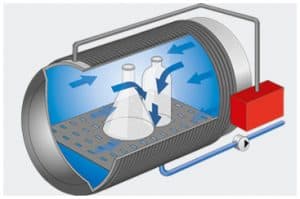
Vacuum system <strong>Vacuum system <span class=”roundlogo dx”>HX</span> </strong> The vacuum device effectively removes the air from solids, tubing, porous materials, and fabrics, allowing the steam to penetrate completely. The process includes a fractionated pre-vacuum phase in combination with the standard steam generator.
-
 Sterilization of hazardous biological substances
Sterilization of hazardous biological substances
Exhaust air filtration with condensate inactivation HX
For the sterilization of hazardous biological substances, Systec autoclaves can be fitted with an optional air exhaust filtration system. The autoclavable sterile filter, consisting of a filter cartridge with PTFE membrane of pore size 0.2 μm, is installed in a presure-proof housing and can be quickly changed at any time.
Exhaust air filtration The filter is also automatically sterilized inline during the sterilization process, monitored by the PT-100 temperature sensor. The condensate is retained inside the pressure vessel during the heating and sterilization phases and thus also sterilized. Through air exhaust filtration and condensate inactivation, it is ensured that no microorganisms can escape before end of the sterilization phase.
-
Additional options
Extension of temperature and pressure ranges HX
Extension of temperature and pressure ranges to 150 °C / 5 bar absolute pressure.
Keep-warm function HX
Keep-warm function for liquids after program has finished.
Potential-free contact HX
The potential-free contact can be used to establish an external potential-free connection to one or more digital outputs or device status lines. This potential-free contact helps to prevent malfunctions when switching external actuators (such as signal lamps, valves and pumps).
Combined heating HX
The combined heating function supplements the built-in steam generator with an external steam heating option.
External heat supply HX
Connection to an external steam source (house steam).
Additional programs HX
such as hydrolitic resistance of glassware*, rubber-closure test**, ramp programs, material test programs.*According to EP 3.2.1 and USP <660>
**According to EP 3.2.9 and USP <381>
Feature for the integration into LIMS and SCADA systems HX
via OPC UA.
Additional PT-100 temperature sensors HX
up to 5 additional PT-100 temperature sensors are available optionally. -
Options for documentation
STANDARD: Internal memory HX

Internal memory The internal memory for process data uses the internal storage; this is part of the Systec PLC. The capacity is sucient to store process data over an average period of 10 years.
STANDARD: Elektronic data output HX

Electronic data output The integrated documentation feature is used for comprehensive batch documentation and for exporting the electronic data as PDF or CSV via network interface or USB. The essential values of the individual program phases and process parameters are presented in a tabular overview, followed by a graph and a numerical table of the program sequence.
*the network interface requires the optional „Save to Folder“ feature for downloading the file to an FTP/SFTP server.
STANDARD: Backup feature HX

Backup feature The backup function (via USB) enables the user to save and restore:
- program lists and their parameters,
- complete backups of the device with the current device software and its databases.
The backup file is encrypted and thus protected against manipulation.
STANDARD: Real-time clock HX

Real-time clock The device has a real-time clock with automatic changeover to daylight savings time. Time, date and time zone can be set manually via the touch screen, the web server or automatically via the internet. A time server and an internet connection are required to automatically set the time.
- automatic summer/wintertime
- automatic leap year detection
OPTIONAL: Save to Folder HX

Save to folder The „Save to Folder“ function automatically exports the current process log to a server after the cycle has been finished. The following server types are supported: FTP, SFTP, FTPS.
OPTIONAL: SCADA connection HX

Scada connection All relevant information (current values of defined analogue and digital inputs and outputs of a device, current process status, alarms) is transmitted by the autoclave using the OPC-UA protocol.
OPTIONAL: Printer HX

Printer An integrated printer is optionally available for documenting the program type, batch number, date, and time. The printout contains the essential information of a program cycle. It shows the basic parameter settings and the success or failure of a program cycle. The printout is created in the language that has been selected on the device.
OPTIONAL: Advanced CFR Part 11 solution HX

Advanced CFR 21 Part 11 solution Data can be downloaded from the autoclave as PDF and/or CSV (Excel) files*, using the USB or network interface**. Both the PDF and CSV files are electronically signed by the autoclave. This electronic signature is clearly assigned to the respective autoclave. It also indicates whether the exported files are valid or not. Any attempt of manipulation will result in the file being marked as invalid.
The advanced CFR 21 Part 11 solution also includes:
- Extended user account control. This includes an individual or global program list for each user, the assignment of the user to an individually created group (e.g. user, supervisor, administrator, cleaner, etc.) which has customizable rights.
- AuditTrail: All executed actions (e.g. changing parameters, starting or stopping sterilization programs) are documented and can be traced back to the respectice user and time stamp (date/time).
- There are up to five fields for electronic signatures. These are used to sign the exported PDF or CSV files on a PC (or any other device with the functionality to sign documents electronically).
* the network interface requires the optional „Save to Folder“ feature for downloading the file to an FTP/SFTP server
** only cycle data can be transferred via the network interface. -
Options for process optimization

Mantle cooling with cooling water and support pressure Mantle cooling with cooling water and support pressure HX
During the entire sterilization process a flexible PT-100 temperature sensor monitors the temperature in a reference vessel. It is guaranteed that the sterilization period begins only once the sterilization temperature has been attained in the liquid to be sterilized. The cooling temperature is also constantly monitored. In accordance with relevant standards to prevent delayed boiling, the lid can only be opened once the temperature of the liquid has been reduced to at least 80 °C.

Radial ventilator Radial Ventilator HX
In conjunction with optional mantle cooling with cooling water and support pressure, the radial ventilator ensures accelerated removal of heat from the sterilization items to the cooled chamber mantle.- Reduction of cooling time by up to 70 %
Ultracooler HX
In conjunction with optional mantle cooling with cooling water, support pressure and radial ventilator, it is possible to significantly reduce the recooling time and the entire sterilization process by integrating of the additional ultracooler heat exchanger.
Ultracooler - Reduction of cooling time by up to 90 %
- Depending on the load, cooling times between 15 and 60 minutes can be achieved

Superdry Superdry – for drying solids HX
This optional accessory increases the drying efficiency for solids and porous materials such as filters and fabrics. Heat energy from the standard steam generator is transferred to the heating coils around the body of the sterilization chamber and is used for drying. Deep-vacuum drying using the optional vacuum device in conjuction with Superdry avoids the necessity for subsequent drying in a separate drying cabinet.

Vacuum system Vacuum system HX
Typical solids are pipette tips (in boxes), empty glassware and porous materials such as filters or fabrics.The vacuum device effectively removes the air from solids, tubing, porous materials, and fabrics, allowing the steam to penetrate completely. The process includes a fractionated pre-vacuum phase in combination with the standard steam generator.
-
Accessories

Loading baskets and inserts
Stainless steel wire mesh baskets and other accesories available upon request. All components are made of stainless steel and are cleanly welded.
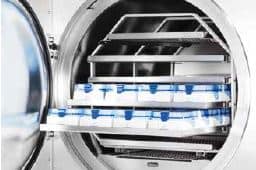
Loading shelves Rack system
To fully utilize the available space in the chamber, especially when sterilizing small items, the autoclaves can be fitted with a rack system. The entire rack system or individual trays can be removed.
Transport cart and transfer cart with Easy Load
Large autoclaves in particular can be easily and securely loaded using special transport and transfer carts. The items to be sterilized can either be placed directly on the transfer cart with rails or using a basket. The transport cart can be moved and docked to the autoclave and fixed in position. The handle can then be loosened to allow the transfer cart to slide into the autoclave on fixed rails.
Transport cart, transfer cart and rack system


